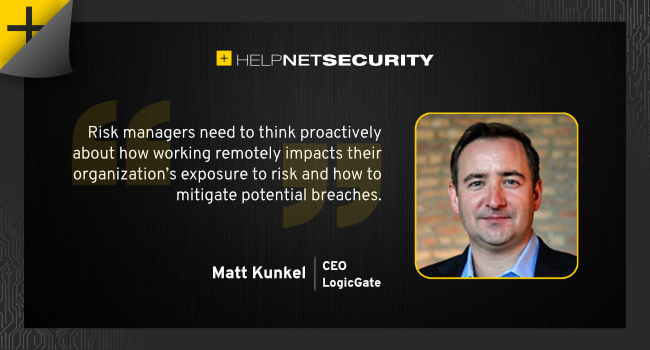Risk management in the digital world: How different is it?
Managing risk arising from remote work has largely been reactive, and risk managers have had to adapt to new digital threats that weren’t necessarily as prevalent when work was done from a physical office.

Risk managers need to think proactively about how working remotely impacts their organization’s exposure to risk and how to mitigate potential breaches. This can happen through constant communication, and end in creating a risk-aware company that gives everyone the ability to assess and counteract risky situations.
Prioritizing and communicating risk
Last year, the number of active phishing websites increased 350% from January to March alone. Now that employees are connecting to the office from their own remote networks and not through their office’s secure network, the chance of a security breach is higher than ever. While risk managers know this already, securing company data is essential to customer trust and longevity. To prioritize risk during remote work, risk managers need to involve executives and keep them updated and educated on potential problems and solutions. Prioritizing risk now will pay dividends in the long run.
Executive teams need to buy in — simply relegating all risk-related work to risk managers isn’t enough in the end. Investing time and money to form a risk-aware culture will better educate all employees on how to avoid common scams and prepare for larger-scale problems. Without prioritization and investment in risk, companies may not make it through the next major disruption and risk major security breaches.
A risk-aware culture can’t be created overnight. Risk managers and executives must first identify the risks and find out where the company stands, aligning risk culture with the existing company culture. Then, they can implement new risk management strategies that may require drastic changes, such as new software, revised policies and educational tutorials on risk. IT teams need to be on top of their game for virtual risks, educating employees and preparing them to ask the right questions. With phishing on the rise and data at a very vulnerable point, employees must be able to assess risk on their own.
Working with technology and automation
Risk management can be assisted by new technologies developing in the IT and automation industries. Utilizing these new features comes at a price but automating tasks for risk management will save time and money in the long run. Companies need to prepare for new methods by creating a stable risk infrastructure before implementing them. Automation, for example, is a force multiplier. It can help streamline risk functions and roles, but risk strategy needs to be sound before implementation — if not, your risk management may fall apart and leave you even more exposed to threats than before.
Robotic Process Automation (RPA) is a technology that helps companies assess risk without much of the tedium usually associated with it. Automated tasks allow teams to focus on important projects that require more human input. With proper procedures in place, RPA will eliminate risk and a lot of the work involved but must be monitored in its early stages to check if it can be implemented on a company-wide basis.
Understanding when risk means opportunity
Risk isn’t always bad. Large-scale risks have the potential to pay off, even in remote work. Investment in risk opens the door for work in sectors that are closed off to those without proper clearance and security. New sectors mean more clients and opportunities. The long-term benefits of proper risk management will outweigh the monetary investment that needs to happen now.
Failure to act on risk can lead to heavy losses. Customers and clients exposed to risk through a company will distance themselves, harming reputation and incurring heavy monetary losses. On the flip side, acknowledging and proactively dealing with new risks will gain trust, leading to better safety, satisfaction and exposure. From there, companies can grow — even remotely — knowing that their data and customer information is safe.
In the end, risks are risks — virtual or not. Actively responding to threats and planning for future challenges will do nothing but benefit the company. For remote work specifically, companies have the opportunity to find weak points in risk infrastructure and build new ways of combating threats before teams return to the office. Planning, investing, and educating now will prepare companies and assure clients that their data is safe, even through the next global disruption.